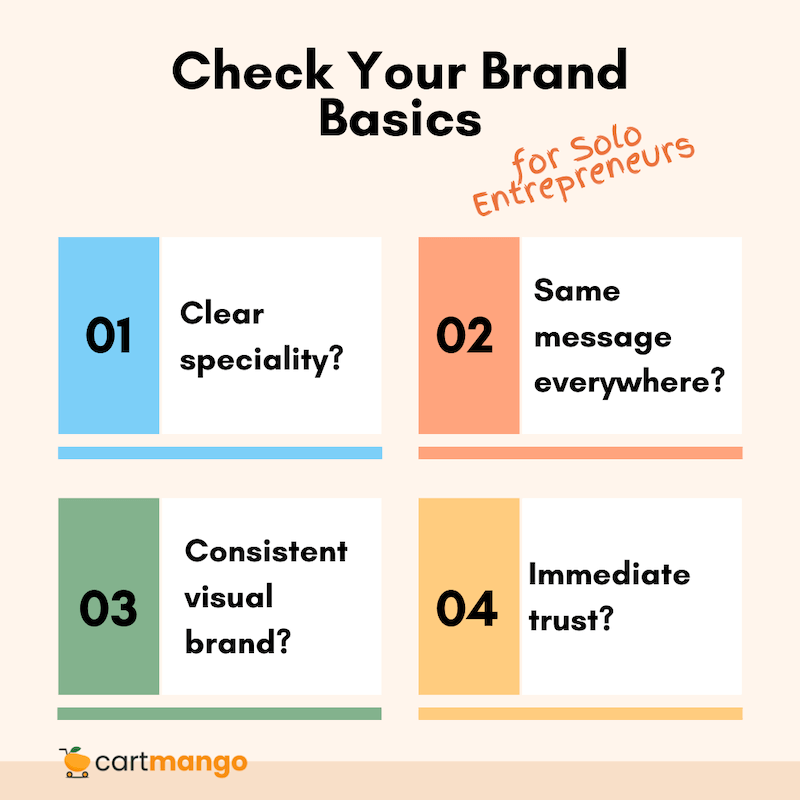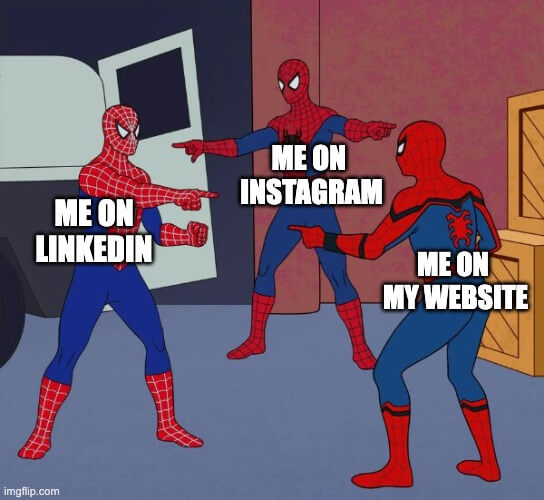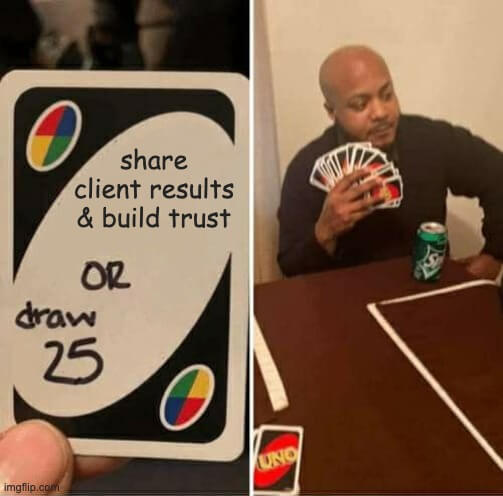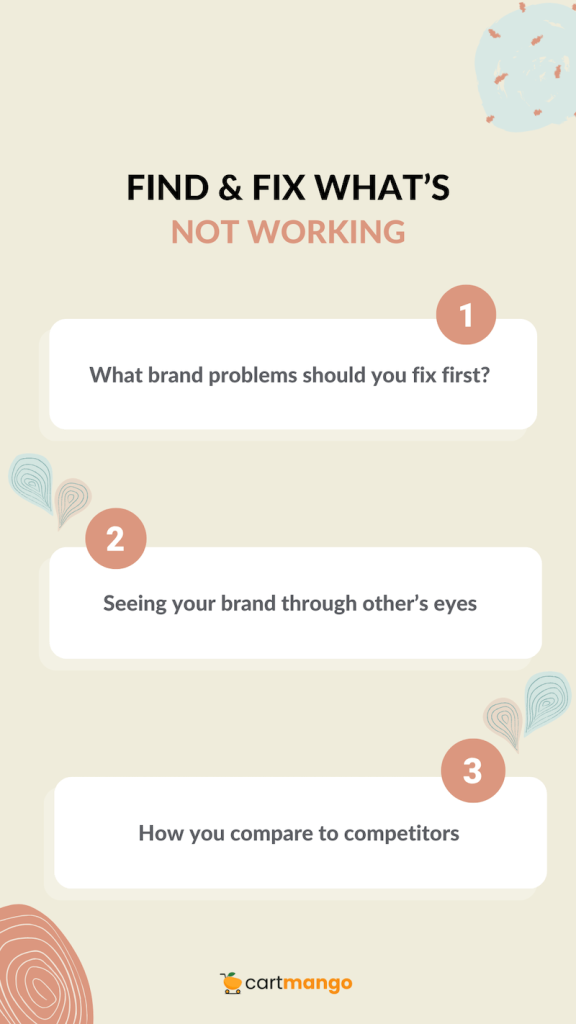In 1 min, use my tool below to uncover the hidden gaps costing you clients right now (while others keep guessing)…
Personal Branding Assessment Tool
Discover how strong your personal brand is as a coach, consultant, expert, course creator, or digital product seller. Answer the questions honestly to receive your personalized score and improvement recommendations.
I am a:
Your Personal Brand Assessment Results
Score Breakdown by Category
Your Brand Strengths
Priority Improvement Areas
Recommended Next Steps
How You Compare
Your personal brand score is average compared to other coaches who have taken this assessment.
Why Your Personal Brand Matters
Your personal brand isn't just your logo or colors.
It's what people think of when they hear your name.
It's about being remembered.
It's about making people choose you over competitors.
Basically, if people know who you are and think you're good at what you do (like having a strong reputation or "personal brand"), you can charge a lot more money for your work. People will pay extra for experts they trust.
According to Hinge's research on Visible Experts, if people know who you are and think you're good at what you do (like having a strong reputation or "personal brand"), you can charge a lot more money for your work. People will pay extra for experts they trust.
This guide will help solo/independent coaches, consultants, course creators, and digital product sellers check their personal brand and make simple improvements.
-
Getting Honest Feedback Without Awkward Conversations
What others think about your brand is just as important as what you think. But asking for feedback can feel uncomfortable.
Try this simple question with clients or customers:
"I'm working on improving how I present my business online. What stood out to you when you first found me?"
This question is easy for them to answer and gives you valuable insights.
For anonymous feedback, use a tool like Google Forms or Typeform. Keep surveys very short (3-5 questions) to get more responses.
Look for patterns in what people tell you. If several people mention the same thing about your brand, it's probably important.
-
Checking the Basics of Your Brand

1/ Is Your Specialty Clear?
People can't hire you if they don't understand what you do.
Many solo professionals try to help everyone with everything, which actually makes it harder to get clients.
Try this quick clarity check: can you fill in this sentence in under 10 seconds?
I help [specific type of person] with [specific problem] so they can [specific benefit].
If you struggled or needed more words, your specialty might be too vague.
Common mistake: Using industry jargon instead of plain language.
For example, a health coach might say:
❌ I facilitate lifestyle modifications for optimal wellness.
✅ I help busy parents lose weight without giving up their favorite foods.
It's clear the second one is much better and clearer.
2/ Does Your Message Stay the Same Everywhere?
Check if your message matches across your:
Website home page
About page
Social media profiles
Email signature
Guest appearances or interviews
Many people describe themselves differently in each place, which confuses potential clients. If someone reads your LinkedIn profile then visits your website, they should feel like they're learning more about the same person—not meeting someone new.
Quick fix:
Copy and paste all your bios and descriptions into one document. Highlight any differences or contradictions. Then create one clear description you can adapt for different platforms without changing the core message.

3/ Does Your Brand Look Consistent?
Your visual brand includes your photos, colors, fonts, logo, and graphics. These visual elements create an impression before people even read your words.
You don't need expensive design work. You do need consistency and a professional look that matches your expertise level.
Simple visual checklist:
Are your profile photos recent and professional-looking?
Do you use the same colors consistently?
Are your fonts easy to read?
Do your graphics look polished, not amateur?
For course creators: Your course thumbnails should have a consistent style that people can recognize as yours.
Digital product sellers: Professional product images can increase sales by making your products look more valuable.
4/ Do People Trust You at First Glance?
Trust happens when people see proof that you know what you're talking about and can get results. Without trust, people won't buy from you no matter how good your services or products are.
The Trust Check for different professionals:
Coaches: Do you share specific client results and transformation stories?
Consultants: Do you demonstrate your expertise through case studies?
Course creators: Do you show student success stories and testimonials?
Digital product sellers: Do you show how your product works and the results buyers get?
Missing trust elements are often the biggest reason qualified leads don't buy. Adding specific proof can quickly increase your conversion rates.

-
Checking How You Show Up Online
1/ Is Your Content Actually Connecting With People?
Content that doesn't connect with your audience wastes your time and theirs. You need to track which content works and which doesn't.
Create a simple spreadsheet with these columns:
Content title/topic
Where you published it
How many people saw it
How many engaged (comments, shares, etc.)
Did it lead to any inquiries or sales?
This tracking helps you see patterns. Maybe your how-to posts get lots of engagement but your personal stories lead to more sales. Or maybe your Instagram content performs better than your blog posts.
Adjust your content strategy based on what the data tells you.
Stop creating content that doesn't help your business goals.
2/ Are Your Social Media Profiles Working For You?
The global creator economy is expected to grow to $528.39 billion by 2033 at a CAGR (compound annual growth rate) of 22.5% (Souce: Globe Newswire).
Social media remains a key driver of this economy, but only if you use it effectively.
Many solo professionals waste time on social media without seeing business results. Each platform requires different approaches, but some basics apply everywhere.
Quick social media profile check:
Does your profile photo look professional?
Is your bio clear about who you help and how?
Do you have a clear call to action?
Are you posting content that actually interests your target audience?
Are you engaging with others, not just posting your own content?
Different professionals need different approaches:
Coaches: Focus on building relationships through conversations
Consultants: Share insights that demonstrate your expertise
Course creators: Give useful teaching samples that make people want more
Digital product sellers: Show your products in action
If a platform isn't bringing you clients or customers after 3-6 months of consistent effort, consider whether it's worth your time.
-
From Assessment to Action
Now that you've checked where your personal brand stands online and offline, it's time to turn insights into action. A personal brand strategy is your roadmap for how you want to be perceived going forward.
What Your Assessment Really Tells You
Your self-assessment helps you gain valuable insights about your professional identity that might not be obvious at first glance. Many business leaders use these checks to spot patterns they couldn't see before.
Don't feel pressured to fix everything at once. Most successful professionals focus on one thing at a time.
Your assessment should help you gain clarity about:
What skills truly set you apart
How you're currently perceived by others
What specific value you bring to clients' or customers' lives
Building Your Unique Value Proposition
Your unique value proposition connects what makes you different with what your ideal clients need. Think of it as the bridge between your abilities and their problems.
When something feels wrong in your brand, it's often because this connection isn't clear. Your first step is to communicate what makes you different in today's crowded professional landscape without trying to appeal to everyone.
Ask yourself: "What positive impact do I create that clients can't easily find elsewhere?" The answer becomes the heart of your compelling narrative.
Strategic Direction (Not Just Tactics)
While the other sections of this guide help with tactical improvements, your strategy sets the overall direction:
Focus on the key areas your assessment showed need the most attention
Gather feedback specifically about what your ideal clients value most
Look for networking opportunities with like-minded individuals who serve similar audiences
Study how leadership brands in your industry position themselves
Analyze which parts of your current approach align with your long-term goals
A personal brand is a powerful tool for building trust and opening new opportunities when used strategically.
Note that your strategy will evolve throughout your professional life. The best personal brands stay true to who you are while adapting to what your audience needs.
-
Real-World Personal Branding Success Stories
Case Study #1: From Corporate Career to Successful Solopreneur
A Reddit user documented their journey from corporate America to freedom, going from zero to $100,000/month in just 2 years. After leaving their finance position in 2012, they tried many business ideas before finding success.
The turning point came when they started a remote cleaning business that later generated millions in revenue. They also launched a software-as-a-service (SaaS) company for home services that reached millions in revenue.
Key personal branding lessons from this case:
They pivoted multiple times until finding the right fit
They leveraged their expertise in one area (websites for home service businesses) to identify a market need
They documented their journey publicly on Reddit, creating a personal brand based on transparency
Their openness about both failures and successes helped others trust them
They focused on sharing practical knowledge rather than theory
The authenticity in sharing both struggles and triumphs made their personal brand particularly strong and relatable to other entrepreneurs.
Case Study #2: Building an Online Course Empire
Another entrepreneur shared how they built and sold an online course business for $6,000,000 in just 2 years. They began by identifying a gap in the market for specialized trading courses in their country.
Their initial attempts failed due to poor presentation and marketing. The breakthrough came when they added a professional sales team, allowing them to scale quickly from $40,000 in the first month to between $150,000-$300,000 monthly.
Key personal branding takeaways:
They recognized that even good content needs proper presentation
They understood their personal limitations and brought in experts to fill gaps
They expanded their course offerings while maintaining quality
They built a community of 13,000 members, creating ongoing engagement
They partnered with other mentors to expand beyond their core expertise
This case demonstrates how a strong personal brand often requires collaboration—knowing when to bring in others to strengthen areas where you're not as strong.

Case Study #3: Becoming a Visible Expert
Hinge Marketing conducted extensive research on "Visible Experts" by interviewing over 1,000 high-profile industry experts and the buyers of their services. Their research identified what these experts did to develop and market their personal brands.
One notable example is Dan Adams, who left his corporate job to start the AIM Institute, helping Fortune 500 companies with new product development.
To build his personal brand, he:
Conducted research on his clients to better understand their needs
Wrote a book establishing his expertise
Spoke at key industry conferences
Blogged regularly on topics of interest to his audience
Used email marketing to nurture his contact list
The research found that visible experts with strong personal brands can charge premium rates—with top experts commanding fees up to 13x higher than average professionals in their field.
This case study shows the systematic approach needed to build a personal brand that positions you as a leading expert in your field.
-
Lessons from These Case Studies
Authenticity beats perfection: The solopreneur who shared both failures and successes gained more trust than if they had only shown their wins.
Know your limitations: The course creator succeeded when they recognized they needed help with sales and brought in experts.
Consistency creates momentum: The visible expert built their reputation through regular content creation and speaking engagements over time.
Community builds brands: All 3 case studies involved building communities around their expertise, not just broadcasting information.
Problem-solving attracts clients: Each success story focused on solving specific problems for their audience, not just sharing knowledge.
Apply these lessons as you build your own personal brand. Small consistent steps are more effective than occasional big pushes.
-
Finding and Fixing What's Not Working

1/ What Brand Problems Should You Fix First?
Not all brand problems hurt your business equally. You need to fix the ones costing you money first.
Use this simple framework to decide:
Quick wins: Easy to fix + high impact = Do these first
Big projects: Hard to fix + high impact = Plan these next
Maybe later: Easy to fix + low impact = Do if you have extra time
Not worth it: Hard to fix + low impact = Ignore for now
Common high-impact issues by business type:
Coaches and consultants: Unclear communication of results you help clients achieve
Course creators: Weak proof that your teaching methods work
Digital product sellers: Poor demonstration of how your product solves problems
Pick the one issue most likely to increase your sales or bookings if fixed. Focus on that before moving to other problems.
2/ Seeing Your Brand Through Others' Eyes
You can't fully judge your own brand because you're too close to it.
You need outside perspectives.
Beyond asking for feedback, try these approaches:
Ask new clients: "How did you find me, and what made you decide to work with me?"
For course students: "What question did my course answer for you that others didn't?"
For product buyers: "What finally convinced you to buy this product?"
These questions reveal what's actually working in your brand from the customer's perspective. The answers often a surprise.
Pay special attention to the exact words people use. Their language can help you improve your marketing messages.
3/ How You Compare to Others in Your Field
Checking out your competition isn't about copying them. It's about finding ways to stand out.
Create a simple comparison chart with:
Names of 3-5 competitors in your exact field
Their specialty/niche
Their main offering
Their unique approach
Their pricing (if public)
What they emphasize in their marketing
Look for gaps you could fill.
Maybe all the coaches in your field focus on one-on-one work, and you could stand out by offering group programs. Or perhaps all the course creators in your niche teach theory, and you could focus on practical application.
The goal isn't to be better at what everyone else does. It's to be DIFFERENT in a way that matters to your ideal clients / customers.
-
Keeping Your Brand Strong: The 90-Day Check-In System
68% of businesses credit brand consistency for 10% to 20% (or more) of their revenue growth (Source).
A simple monitoring system prevents your brand from becoming outdated.
Set aside 2 hours each month to:
Check your brand's alignment with your current offerings
Review recent client/customer feedback
Look at your content performance
Monitor mentions of your name online
Then every 90 days, do a deeper review:
Has your business direction or target audience changed?
Are you getting the right kind of clients or customers?
Is your messaging still clear and relevant?
Do your visual elements still represent you well?
Small, regular adjustments prevent the need for complete brand overhauls. Keep a simple dashboard or checklist to track changes over time.
-
Helpful Tools That Don't Break the Bank
You don't need expensive tools to manage your personal brand. These free or low-cost options work well for solo professionals:
Canva: Create consistent visuals for social media and websites
Google Forms: Gather client/customer feedback
Grammarly: Ensure your writing is clear and error-free
Google Alerts: Monitor mentions of your name online
Many paid tools offer free versions with enough features for solopreneurs. Start with free tools and upgrade only when you have a specific need the free version can't meet.
-
What Next For Your Personal Branding Assessment?
Assessing your own personal branding can be intimidating.
Regardless of your personal branding is doing though... you can always improve it in 5 steps:
Take the quiz at the top of this post to get your baseline score
Choose just ONE area to improve first
Set aside 30 minutes twice a week to work on it
Ask for feedback from someone who will be honest with you
After 30 days, retake the quiz to see your progress
Your personal brand evolves as your business grows. What works now might not work next year. Regular assessment keeps your brand aligned with your goals.
The clearer your personal brand, the easier it is for the right people to find you and decide to work with you.
Related
- SendOwl vs SamCart: The Recurring Revenue Jail (2026)
- ThriveCart vs ClickFunnels: When more features hurt (2026)
- SendOwl vs Payhip: The “You-Leave-You-Lose” Model (2026)
- SamCart vs Kajabi: The Income Hostage Trap (2026)
- Sellfy vs Payhip: The Recurring Revenue Prison (2026)
- Podia vs Gumroad: The Recurring Revenue Handcuffs (2026)
- SendOwl vs Gumroad: The Recurring Revenue Black Hole (2026)
- Gumroad vs Sellfy: The Vendor Lock-in Cage (2026)
- Gumroad vs Payhip: The Hidden Trap for Creators (2026)
- ThriveCart vs SamCart – The Subscription Hostage Trap (2026)
